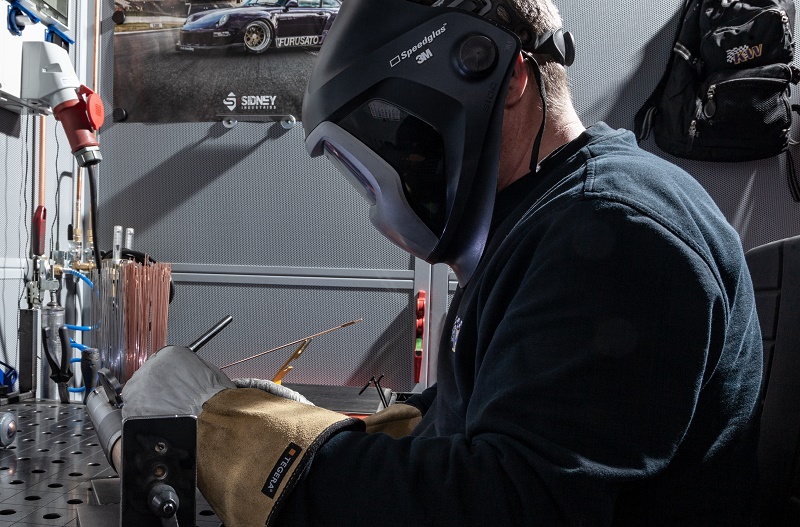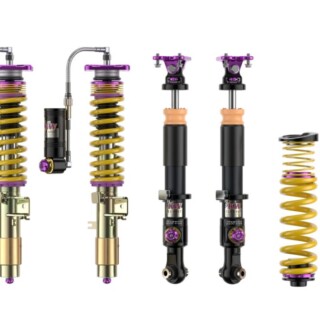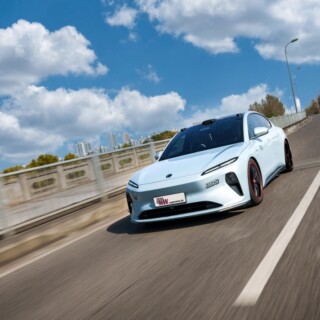
For several years this Ford Escort Mk II stood all by itself in a Finnish front yard. So you can call it luck that this Ford was rotting away directly in a garden on Sebastian Sundfors’ way to school. At only 17 years, Sebastian bought the escort for 900 euros. Gear damage, moss, and severe amounts of rust included.

After 15 years of several stages of car expansions, Sebastian isn’t keen on rebuilding his Ford anymore. Interest awakened? Automotive enthusiasts are now able to purchase Sebastians Escort. His new car of interest is a Ferrari 308 GTB.

Back to Sebastians Ford: Many fans of old cars are attached to the 1974 to 1980 built Mk II Escort. No wonder we at KW automotive develop coilover kits for the craziest projects born in long Finnish winters such as Sebastian Sundfors’ project.
The first wild ideas are taking their course

At first, the Ford was planned for a simple winter project. For that, the Escort was disassembled into its single parts. That was the moment Sebastian realized he bought a real rusty scrap car. “All sealing rubbers were brittle and it rained through the sunroof” he remembers. Frightened, Sebastian Sundfors remembers the wet floor under the car mats and cladding elements.
While recompiling the Ford Escort Mk II Sebastian decided that the invested time and effort were too good to waste for the car to only be a winter project. Wouldn’t it be better to race over forest roads in summer and winter? In Sebastian’s opinion no: He decided to get rid of the old 1.3-liter-motor and put a 1.6-liter-motor aboard.
Apparently, a 1.6-liter-cubic capacity wasn’t the best option in the long run. A gearbox with a two-liter motor followed which was tuned with SK Racing Carburetors. The old rear axle was replaced with a modified Volvo 740 four-link rear axle with a Panhard stab. The serial dampers were exchanged with dampers that are adjustable in compression and rebound.

Nevertheless, the old Pinto machine wasn’t the best option anymore. Sebastian also lost interest in the idea of a Rallye-Escort and after a rough street usage, the no-name dampers were destroyed.
A new idea was born: A SR20DET under the hood

“I bought an SR20DET of a Nissan S13 and began to think about a self-made body kit to remodel the Ford into a track tool. By accident, I discovered a 2.5-liter-BMW-motor for good money.”

Actually, the BMW engine was to be installed in an M3 replica, but Sebastian made the mistake of hoisting the S14 into the empty engine compartment of his Escort with help of an engine crane. Somehow the engine seemed to fit in perfectly since the Ford turned more and more into a trellis frame body with customized Escort design language.

Nevertheless, Sebastian didn’t continue to modify the Ford Escort afterward. In 2009 he started studying mechanical engineering and ended his studies with a master’s degree in 2013.
A radical new start after a seven-year break

“Between 2015 and 2017 I started building a house, got married, became a father, and made the mistake to sell the M3 motor. This made me buy another S14 motor – with help of my wife.” Sebastian says with a smiling face.

But the fact that the Ford is looking as good today as you see in the pictures from Summer ’21 is simply because a friend surprised Sebastian by entering his Escort in the 2018 Bilsport Performance & Custom Show. Somehow, this was the external starting aid for Sebastian to go full speed with the remodeling of his Ford Escort.

“Luckily, my friends and two brothers Benjamin and Emanuel helped me out” Sebastian says thankfully. His wife Cecilia was also an aid: She took over the fabric decor of the interior.

Basically, only the A-, B- and C-pillars as well as parts of the chassis on the 1979 Escort have remained original; while a large part of the non-load-bearing body elements was made from self-made carbon parts, aluminum, GRP, and new sheet metal parts.
This is one of the reasons why the initial roll bars with flank protection have evolved into a self-welded safety cell with a tubular frame. Needless to say, these parts are welded to the rest of the chassis.

When having a look in the cockpit, the black cladding at the gearbox tunnel and the car floor panel catch your eye. These are black powder-coated aluminum plates Sebastian mounted with stainless steel bolts. “To simplify the maintenance of the Ford, I can easily remove the cladding. Even the parts of the chassis firewall are removable.” Sebastian says.
Braking and accelerating are done with adjustable upright pedals which are self-made by Sebastian. “I built them with various components just as my height-adjustable steering column.” he says. By the way, Sebastian works as an engineer in the marine industry and develops fuel tanks in his everyday work.

The entire body kit with its “flip-front” is also self-made. The hood is made of carbon fiber and fiberglass and can be removed together with the radiator grille, headlights, bumpers, spoiler, and fender flares.

What a view: the carbon-clad intake manifold with a single throttle system. This is also self-made and is based on the hardware of a BMW M5.

What isn’t self-made is the two-way adjustable KW Competition coilover kit made in Fichtenberg, Germany. To manufacture a custom-made coilover kit for Sebastians Ford the Finn passed all technical data of his self-designed steering and axle geometry. Vehicle weight, weight distribution, desired spring deflection, wheel size, wheel dimensions, and aimed engine power.

Afterward, our colleagues from the KW motorsport and special construction department made a customized coilover kit for the Ford Escort Mk II. Not a big deal for KW since basically all coilover kits are custom-made here.

Often not until someone orders a coilover kit at one of our retail partners or in the online shop of KW suspensions or ST suspensions, we start manufacturing in Fichtenberg.
This also applies to our other coilovers such as the KW V1, KW V2, KW V3, KW V4, KW V5, and all other coilover kits that are found in our product range. The reason for that is that at the beginning of the day we never know which orders there will be for which kind of cars. And every car needs to be equipped with a different coilover kit.

This means that we build around 350 different coilover kits for 350 different car models. That leads to a lot size of 1 in 350 to 380 of 400 total manufactured coilover kits on a normal day.

For Sebastian’s tubular frame Ford with the self-made and modified axle geometry, we manufactured a custom-made coilover. His KW coilover kit is based on racing coilovers, a KW Competition coilover kit with inverted monotube design (MacPherson struts in upside-down design).

Many thanks also to Sebastian’s good friend Daniel Käldström of Dk Films who took all those beautiful photos of the KW coilover kit.

No matter if two-way, three-way, four-way, or five-way adjustable: We use wheel-guiding MacPherson struts which are manufactured in an inverted monotube (Upside-Down) with a KW damper cartridge in vehicles with high lateral control forces.

Here you can see one of the greatest four cylinder engines ever build: a BMW S14B25. At 7000 revolutions per minute the 2.5-liter four-cylinder has a performance of 238 hp.

This was a little too less for the Finnish man. As a car enthusiast, he already knew that he could push the S14B25 up to 360 hp. This way, Sebastian’s motor was revised with Wössner forged pistons, Köhler Racing dry-sump lubrication system, and many more accessories.

The single-throttle system from the BMW M5 (S38B38) is installed with an intake manifold made of carbon and the air filter box comes from the 3D printer of BBT motorsports.

But this is not everything: Mounting material for the KW coilover kit, mounting brackets, and many more were made with the 3D printer. “As a material, we used a carbon composite material (PA-CF)” the engineer says.

In combination with the exhaust system and the revised engine control unit (Motec M84 ECU) the performance of the BMW M3 motor was at 300 hp. Furthermore, a modern CAN bus system came aboard. Via the Motec PDM control unit, the entire electricity can be controlled individually. Fuel pump, windshield wipers, and auxiliary motor fan included.

The ZF five-speed gearbox (ZF S5-31) revised and completely synchronized by the company Gearmotive. The self-made exhaust system with its exhaust manifold winds its way along the underfloor and ends with two motorcycle mufflers. “Those are from Yoshimura and were actually intended for a Hayabusa.” Sebastian admits. Road legal papers for his Ford is not important to him, because it is a showcar.

The tank is also self-made and equipped with a high-performance fuel pump with an additional pump and CatchTank in the back and trunk. There is also an Air jack system.

Sebastian thought about a complete coating in the popular “Nardo Grey” of Audi. Nevertheless, in the end, it became Steel Grey (RAL7037).

The remodeling is made complete with Makrolon polycarbonate and plexiglass glazing, tinted windows, black-tinted rear lights, and a trunk tear-off edge made of carbon fiber.
The multi-piece light-alloy wheels are Japan Racing JR26 wheels in 10 x 17 inches (offset at 0). They are tired up with 245/35-17 Hankook sport tires. The brake is from K Sport. “This is a custom-made six- and four-piston system with 286-millimeter brake discs in each case.”

As beautiful as the Ford is, Sebastian never really got to drive it: “This somehow got out of control. Photo shooting, adjustment drives, and test drives included, I sat 600 kilometers behind the steering wheel.”

At the moment, Sebastian is still unsure whether he should sell his Ford or not. Those who are interested can contact Sebastian via his Instagram profile.
Photos: Private, Daniel Käldström (Dk Films)



















